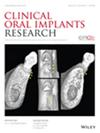Effect of Auxiliary Occlussal Devices on the Occlusal Accuracy of Multiple Implant‐Supported Restorations Fabricated Using Digital Workflow: A Randomized Control Trial
IF 5.3
1区 医学
Q1 DENTISTRY, ORAL SURGERY & MEDICINE
引用次数: 0
Abstract
ObjectiveThis study aimed to evaluate the effectiveness of auxiliary occlusal devices (AODs) in improving occlusal accuracy and reducing clinical adjustments in a fully digital workflow for multiple (3 or more) implant‐supported single crowns.Materials and MethodsTwenty‐nine patients with a total of 106 implant‐supported single crowns were enrolled. Participants were randomly assigned to either the test group (with AODs) or the control group (without AODs). Both groups underwent a digital workflow, and the morphology of restorations was recorded before and after occlusal adjustment using an intra‐oral scanner. Quantitative occlusal modifications, including grinding and porcelain additions, were calculated by 3D analysis software, and crown remake (occlusal deficiency > 0.5 mm) was documented. Statistical analysis included the Mann–Whitney U test, Fisher's exact test, and generalized linear mixed model to assess the effects of group assignment, edentulous position, and their interaction on the amount of occlusal adjustment.ResultsThe test group exhibited significantly lower rates of porcelain addition (16.4% vs. 26.3%,辅助咬合装置对使用数字工作流程制作的多种植体支撑修复体咬合准确性的影响:一项随机对照试验
目的本研究旨在评估辅助咬合装置(aod)在全数字化工作流程中提高咬合准确性和减少临床调整的有效性,用于多个(3个或更多)种植体支持的单冠。材料和方法纳入29例患者,共106个种植体支撑的单冠。参与者被随机分配到实验组(有aod)或对照组(没有aod)。两组都进行了数字化工作流程,并使用口腔内扫描仪记录了咬合调整前后修复体的形态。通过3D分析软件计算定量的咬合改变,包括研磨和瓷添加,并记录冠重制(咬合缺陷>; 0.5 mm)。统计分析采用Mann-Whitney U检验、Fisher精确检验和广义线性混合模型来评估分组分配、无牙位置及其相互作用对咬合调整量的影响。结果实验组的烤瓷添加率(16.4%比26.3%,p = 0.051)和冠重制率(3.8%比20.4%,p = 0.015)显著低于对照组。AOD组的绝对咬合矫正量(中位数0.3290 mm)明显低于对照组(中位数0.5273 mm, p = 0.001)。值得注意的是,游离端鞍冠显示出更高的咬合瓷添加发生率(p = 0.022),但在这些病例中使用aod显著减轻了调整的需要(p = 0.007)。结论将aod纳入数字化工作流程,可显著提高咬合配准精度,减少椅侧修改和重做。在复杂的情况下,如游离端鞍座,aod特别有益,应该被认为是指种植义齿中有价值的辅助材料。本研究已在中国临床试验注册中心注册(https://www.chictr.org.cn/; ChiCTR2200064819)。
本文章由计算机程序翻译,如有差异,请以英文原文为准。
求助全文
约1分钟内获得全文
求助全文
来源期刊

Clinical Oral Implants Research
医学-工程:生物医学
CiteScore
7.70
自引率
11.60%
发文量
149
审稿时长
3 months
期刊介绍:
Clinical Oral Implants Research conveys scientific progress in the field of implant dentistry and its related areas to clinicians, teachers and researchers concerned with the application of this information for the benefit of patients in need of oral implants. The journal addresses itself to clinicians, general practitioners, periodontists, oral and maxillofacial surgeons and prosthodontists, as well as to teachers, academicians and scholars involved in the education of professionals and in the scientific promotion of the field of implant dentistry.
 求助内容:
求助内容: 应助结果提醒方式:
应助结果提醒方式:


